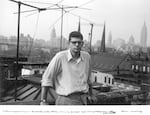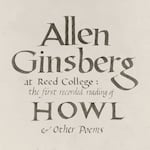
Beat poet Allen Ginsberg, photographed on a rooftop by William S. Burroughs in 1953.
Courtesy of Allen Ginsberg Estate / Courtesy of Allen Ginsberg Estate
“I saw the best minds of my generation destroyed by madness, starving hysterical naked….”
So begins one of the most famous poems of the Beat literary movement: Allen Ginsberg’s epic, “Howl.” Written in the mid-1950s, the poem is dedicated to fellow writer Carl Solomon, who Ginsberg met at a psychiatric institution. Once the subject of an obscenity trial, it’s now regarded as a seminal work in American literature.
“The poem is very political, and it is an attack on the conformism of ’50s Eisenhower McCarthyism,” said Pancho Savery, a Reed College professor of English and humanities. “And it is simultaneously a lament for the people who have suffered under those politics.”
The first time Ginsberg ever publicly read “Howl” was at Six Gallery in San Francisco, a city at the heart of the Beat movement, in October 1955. Other writers in attendance that night included Gary Snyder, Michael McClure, Jack Kerouac and Lawrence Ferlinghetti. But the reading, sadly, went unrecorded.
For many years, it was thought that the first time Ginsberg was recorded reading “Howl” was March 1956 in nearby Berkeley. But it turns out that the first recording took place a month earlier, on Valentine’s Day, in the lounge of a dormitory at Portland’s Reed College.
Related: Literary Arts: The Archive Project
After the Six Gallery reading in 1955, Snyder and Ginsberg decided to take a road trip together up the West Coast to the Pacific Northwest. Snyder, along with fellow Beat poets Philip Whalen and Lew Welch, were all Reed College alumni.
“And so, it was a natural place for Snyder to take Ginsberg on their journey through the Northwest,” Savery said.
The reel-to-reel tape recorded on Feb. 14 — the second of two nights Ginsberg read at Reed — was long forgotten. That’s until author John Suiter stumbled upon it in a box at Reed’s Hauser Memorial Library in 2007 in the course of his research into Gary Snyder. This month, a restored version of the archival recording was released on multiple formats — including on vinyl — by Omnivore Recordings. The release’s liner notes, written by Savery, calls the recording “Allen’s Valentine” and begins, “what you are holding in your hands is a piece of American literary history.”

The album cover of Omnivore Recordings' Allen Ginsberg — At Reed College: The First Recorded Reading of Howl and Other Poems. Title calligraphy by Reed College's Gregory MacNaughton.
Courtesy of Omnivore Recordings / Courtesy of Omnivore Recordings
The discovery of the Reed Ginsberg tape by Omnivore Recordings’ cofounder Cheryl Pawelski was serendipitous. The record label specializes in restoring and re-releasing vintage recordings. The Grammy Award-winning producer attended a rainy women’s rugby match at Reed with her wife Audrey Bilger, who’s served as the college’s president since 2019. They got to chatting with Gregory MacNaughton, the coordinator of Reed’s Calligraphy Initiative and, as Pawelski tells it, a big fan of Beat-era poetry. Naturally, the 2007 find of the Ginsberg recording came up in conversation.
“That’s a dog whistle for me,” Pawelski said.
Omnivore had worked with Allen Ginsberg’s estate in the past and, once she heard about this recording, she was eager to do so again.
“I just had a feeling they’d be excited about this and they’d be willing to allow us to do another project,” Pawelski said. “They pretty much said yes just immediately, because it is such a historic find — and to make it more widely available — I think they were as excited by that prospect as I was.”
She connected with her collaborator and fellow Grammy winner Michael Graves, “one of the best restoration guys on the planet,” to move forward on the project.
“It wasn’t like the microphone that Ginsberg was speaking into was direct into some sort of recording device. It was an audience recording. ... It’s even more special because of that, because you can hear the room ambiance,” Pawelski said.
“It’s really nice because this wasn’t one of those that we had to save,” she said, “Mike’s job on this one was to let it breathe and just, let the room be present. And I think we achieved that.”
Savery said the size of the lounge at the dorm where the reading took place, Anna Mann Cottage, tells him that the crowd couldn’t have been more than 50 people, tops. In the recording, the intimacy of the space is evident in the occasional bursts of laughter at some of the funnier lines in Ginsberg’s poems. But through most of “Howl,” the audience sits rapt, so quiet you can hear Ginsberg turn the pages of his notebook. Pawelski said that if you turn up the volume loud enough, at one point in the tape, you can hear a plane fly overhead.
“The audience was very reverential, which was nice, considering it’s college kids,” she said.
If you listen to the recording while reading along with the finished version of “Howl” (famously published in pocket paperback by San Francisco’s City Lights Books), you soon realize that what Ginsberg read at Reed was a work in progress. In some places, whole sections of the poem move around. In others, just a word or phrase is tweaked; a flourish here, a simplification there. Sixty five years later, it’s a living, breathing work.
Savery points to the strong presence of jazz in the poem’s content and the musicality of its form. Jack Kerouac, a practitioner of “spontaneous prose,” helped get Ginsberg into jazz. While winding up to read “Howl” at Reed, Ginsberg mentions the work of jazz saxophonist Lester Young specifically, and bop composition more generally, as influences.
“One of the things I hear is the repetition of long lines,” Savery said. “If you listen carefully to Lester Young, you can hear him performing his lines in the same way.”
Ginsberg later referred to the poem’s lines, most of which begin with the word “who,” as “long saxophone-like chorus lines.” He takes deep breaths before each one.
It becomes clear that reading the epic poem aloud was actually a physically and emotionally exhausting experience for Ginsberg. It’s one Savery gained insight into himself, when in 2007, upon the recording’s discovery, he was asked to read “Howl” at Reed.
“The decision that I made was, in order to warm up both breath-wise and emotionally-wise, I wanted to start out by reading several of Ginsberg’s shorter poems as a way to ease into the process of reading ‘Howl.’ And it turns out that, in the recording, Ginsberg himself did exactly the same thing. He read several shorter poems in order to build up his emotions,” Savery said.
Omnivore’s release includes several shorter poems that Ginsberg read that night as a warm-up (including my favorite, “A Supermarket in California”).
When it comes time to read Howl, though, Ginsberg hesitates, and says he doesn’t know if he has the energy. He asks the time, if an unnamed woman had arrived yet, and then if there is anyone at the reading who hadn’t attended the night before. “I hate to go through all that again,” he chuckles under his breath.
“Interestingly enough, after he started reading the poem, he in fact could not get through the whole thing, and he ended up stopping in the middle,” Savery said.
Indeed, about a minute into part two of the poem, Ginsberg says, “I don’t really feel like reading anymore. I’ve sort of like … I haven’t got any kind of steam. So I’d like to cut, do you mind?” A second later, the low fuzz of the room tone abruptly ends, and the recording is over.
Ginsberg’s open and often explicit references to sexuality in “Howl” and his other works made him a particularly controversial figure in the 1950s and throughout his career. Later in life, Ginsberg became a member and proponent of the “North American Man/Boy Love Association,” or NAMBLA, a pedophilia advocacy group that sought to abolish age-of-consent laws.
A piece of Reed history
Sixty five years after it was recorded, the “Howl” tape is part of Reed’s history.”
Pawelski said it was important to her to include elements of Reed College in the restored Omnivore Recordings release. She commissioned Savery to write the record’s liner notes for this reason. And, to help solve the problem that there was no photos or flyers from the reading, she enlisted MacNaughton of Reed’s Calligraphy Initiative, who’d told her about the recording in the first place. He created an album cover in calligraphy reminiscent of the era.
“I felt it was really important to tie it back to where it belongs,” Pawelski said.
Both she and Savery said it makes sense that Reed College is where this historic reading took place.
“It is a very progressive and intellectually challenging place,” Savery said. “And the motto on Reed’s sweatshirts is ‘Communism, Atheism and Free Love.’ And so, for that reason alone, it was the appropriate place for Ginsberg to read a poem that is about all three of those things.”
He added that students of literature today can listen to Ginsberg’s reading and hear “the real emotions that the poem is trying to convey.” They can take away from the recording just how significant and relevant the poem still is, after all this time.
“Its attack on the conformism of the 1950s is still important. Its connection to jazz is still important. Its connection to Buddhism is still important. It’s revealing things about the difficulty of mental illness that [are] still important. The celebration of nakedness is still important. And Ginsberg as a writer, putting himself in the tradition of American epic poems — Ezra Pound, William Carlos Williams, Louis Zukofsky — that is also continually relevant,” Savery said.
For Pawelski, listening to Ginsberg’s Reed tapes is time travel. It’s an experience she hopes to share.
“You preserve things by making them available,” she said. “My idea about preservation is, you do it through proliferation.”
Pawleski continued: “A lot of the work that I do is, I’m trying to throw things into the future, you know? And this is that. It’s an important piece of literature and poetry from the 20th century, and here’s another version of it, and if I can throw that forward for other people to find more easily, then I have done my job.”
Listen to the full interview with Professor Pancho Savery, and hear snippets of the Ginsberg recording, using the audio player at the top of this page.
Editor’s Note: This story has been updated to include context on Allen Ginsberg’s advocacy of a group that promoted pedophilia and sought to abolish age-of-consent laws.
